|
|
|
Sort Order |
|
|
|
Items / Page
|
|
|
|
|
|
|
| Srl | Item |
| 1 |
ID:
120221
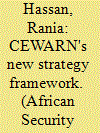

|
|
|
|
|
| Publication |
2013.
|
| Summary/Abstract |
A decade after establishing the Conflict Early Warning and Response Mechanism (CEWARN) of the Intergovernmental Authority on Development (IGAD), the member states endorsed the new strategy framework that is to guide the work of CEWARN until 2019. Although the original legal foundation upon which CEWARN was founded did not specify the types of conflicts that it could be involved in, CEWARN chose to limit itself to cross-border pastoral conflicts. This was partially due to the low levels of confidence between the member states, which prevented CEWARN from engaging in other types of conflicts that are considered to be more 'political' and thus more 'sensitive'. The hope was that after asserting its own success in dealing with cross-border pastoral conflicts, CEWARN would be able to expand its geographical as well as thematic scope. Thus, the most pronounced aspect of the new strategy framework is the expansion of CEWARN operations beyond their current limited focus. Although it is too early to assess the new strategy framework, I attempt to provide a reading of the future of this strategy plan, with particular reference to Sudan and South Sudan. I argue that despite the rhetoric that accompanied the endorsement of the new strategy, the prospects of the new plan in Sudan and South Sudan depend on a number of factors: first, enhancing the mutual trust between Sudan and South Sudan with regard to exchange of information; second, changing Sudan's perceptions with regard to IGAD; and third, securing the much-needed funding for such an expansion of CEWARN's work.
|
|
|
|
|
|
|
|
|
|
|
|
|
|
|
|
| 2 |
ID:
120225
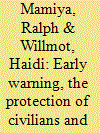

|
|
|
|
|
| Publication |
2013.
|
| Summary/Abstract |
This commentary traces the increasing importance of early warning in United Nations (UN) peacekeeping, an emphasis that has emerged in connection with the evolution of protection of civilians mandates in UN peacekeeping missions. It examines the current and emerging practice of early warning in UN peacekeeping as well as the challenges faced, drawing on case studies from the UN missions in South Sudan and the Democratic Republic of the Congo. The authors also propose a set of basic principles upon which early warning in UN peacekeeping operations might be approached in the future.
|
|
|
|
|
|
|
|
|
|
|
|
|
|
|
|
| 3 |
ID:
120220


|
|
|
|
|
| Publication |
2013.
|
| Summary/Abstract |
The Intergovernmental Authority on Development's (IGAD) Conflict Early Warning and Response Mechanism (CEWARN) 2012-2019 Strategy Framework has proposed that the CEWARN mechanism expand its conflict typologies and geographic coverage. The argument advanced in this paper is that the proposed CEWARN expansion should be welcomed. Since its establishment in 2003, CEWARN had restricted itself to dealing with cross-border pastoral conflicts among the member states. However, conceptually and legally, CEWARN was not precluded from dealing with other types of conflict. Firstly, in the past, any conflict, other than cross-border pastoral ones, had been considered by the member states as firmly within their national jurisdiction that mechanisms like CEWARN are precluded from handling. Secondly, CEWARN, which has hitherto been dependent on external donations, just does not have the requisite financial resources to expand its coverage. Thirdly, and most importantly, governments often know the imminence of some, if not all, of the conflicts because they cause them. Thus, they are not interested in reacting to them. In the end, the paper concludes that the proposal to expand CEWARN's conflict portfolio and geographic spread may just remain that - a proposal.
|
|
|
|
|
|
|
|
|
|
|
|
|
|
|
|
| 4 |
ID:
120226
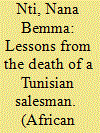

|
|
|
|
|
| Publication |
2013.
|
| Summary/Abstract |
The Arab Spring was triggered by the self-immolation of a Tunisian salesman leading to protests by ordinary people empathising with the salesman and demanding bread, jobs and a change in the lives of the youth. With the expansion of the movement to include internal and external political opposition, and in response to the hard-line tactics of beleaguered leaders, the focus of the uprising became a clarion call for leadership changes. However, two years after the start of these uprisings, Tunisia, Egypt and Libya are still in a state of crisis, even though new leaders have been elected into power. Thus, to contribute to the early detection of similar uprisings, their prevention and resolution, this article refocuses discourse and policy decisions about the Arab Spring back to the original demands of the protestors and to its root causes, namely the demand for improved lives. This will be done by analysing the life, death and memorial of the father of the Arab Spring: Mohamed Bouazizi.
|
|
|
|
|
|
|
|
|
|
|
|
|
|
|
|
| 5 |
ID:
120227
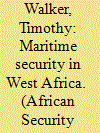

|
|
|
|
|
| Publication |
2013.
|
| Summary/Abstract |
This article will briefly examine the maritime security situation in 2013 in the Gulf of Guinea and the coast of West Africa, where a number of internationally integrative approaches for improving counter-piracy efforts are being developed. As the maritime domain is both vast and complex, the article focuses on two of the major problems causing the present situation of maritime insecurity - firstly, piracy and armed robbery at sea, and secondly, Illegal, Unreported and Unregulated (IUU) fishing. The progress in the provision of maritime security in regards to both problems is assessed. Finally, a number of concise recommendations for improving maritime security are highlighted.
|
|
|
|
|
|
|
|
|
|
|
|
|
|
|
|
| 6 |
ID:
120222
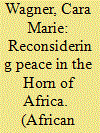

|
|
|
|
|
| Publication |
2013.
|
| Summary/Abstract |
After only ten years in existence, the African Union (AU) has already made its mark on the landscape of peace and security in Africa. This paper seeks to explore the relationship between the AU's leading collaborative interstate security policy, the African Peace and Security Architecture (APSA), and sustainable peace in the Horn of Africa. It examines four countries - Djibouti, Eritrea, Ethiopia, and Kenya - and how engaging with the APSA through early warning systems can contribute to developing the elements necessary for sustainable peace, namely regional stability, conflict management, and good governance.
|
|
|
|
|
|
|
|
|
|
|
|
|
|
|
|
| 7 |
ID:
120219


|
|
|
|
|
| Publication |
2013.
|
| Summary/Abstract |
This article examines the state of the art of early warning in Africa. It looks at the definitions of early warning, considers the historical evolution of conflict early warning systems, and takes a critical look at the debate about the link or the gap between early warning and early action. To this end, it tries to answer some important questions, particularly in relation to the purpose of early warning systems (EWSs) and their limitations so as to ensure that EWSs and early warning analysts are taken for what they are, and not criticised for what they are not or cannot do. In essence, it underscores the fact that the field of conflict early warning is not a fortune-telling business; an industry aimed at predicting socio-political events. The field and its different actors and mechanisms typically serve various purposes and rely on networks and open sources as well as cooperation. At times, some actions are indeed taken and potential conflicts prevented, but these actions do not come to the attention of outside observers precisely because nothing happened. It acknowledges, however, that the field can still learn from past experiences and improve on its delivery, at the level of both analysis and the ensuing action.
|
|
|
|
|
|
|
|
|
|
|
|
|
|
|
|
| 8 |
ID:
120224


|
|
|
|
|
| Publication |
2013.
|
| Summary/Abstract |
In June 2000, the Conference of Heads of State and Government of the Economic Community of Central African States (ECCAS) adopted the Protocol on the establishment of the Peace and Security Council for Central Africa (COPAX), with its two technical structures, namely the Central African Multinational Force (FOMAC) and the Central African Early Warning Mechanism (MARAC). MARAC is tasked with collecting and analysing data for the early detection and prevention of conflicts and crises. It currently consists of the Central Structure located at the ECCAS Executive Secretariat in Libreville (Gabon) and 31 Decentralised Correspondents spread throughout the ten member states of ECCAS. This article assesses the performance of MARAC in the light of its assigned objectives. Bearing in mind the peace and security challenges facing the central African sub-region, the central argument of this article is that while the establishment of MARAC is commendable, it flowed more from the logic and context of the establishment of similar mechanisms on the African continent during the same period than from any displayed capacity and/or readiness on the part of ECCAS to implement the recommendations due to emanate from such a structure.
|
|
|
|
|
|
|
|
|
|
|
|
|
|
|
|
|
|
|
|
|